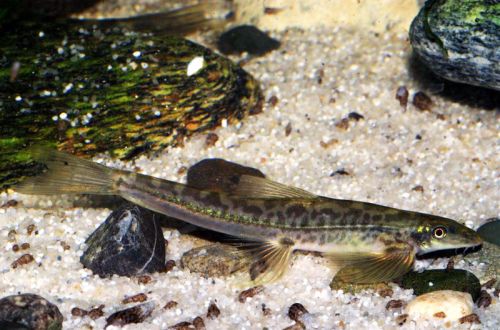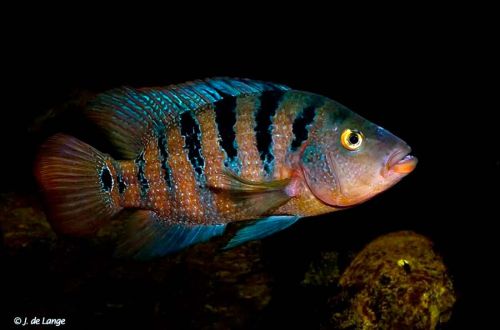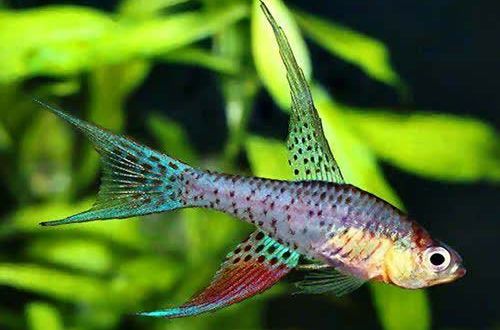
Heckel Discus
The Haeckel discus, scientific name Symphysodon discus, belongs to the Cichlidae family. An elegant and graceful specimen of the Discus genus, it stands apart from its relatives due to its original coloration – there are three pronounced vertical dark stripes in the body pattern. For its appearance, the fish also received the names Pompadour Fish or Pineapple Fish.

At home, this species has been kept since the middle of the 19th century, which makes it one of the oldest aquarium fish. However, this circumstance did not affect the popularity of the Discus Haeckel due to the difficulty of care and breeding. Most of the fish for sale are still caught from the wild.
Requirements and conditions:
- The volume of the aquarium – from 200 liters.
- Temperature – 28-32°C
- Value pH — 4.2–6.2
- Water hardness – very soft (1-5dH)
- Substrate type – sand or gravel
- Lighting – moderate
- Brackish water – no
- Water movement is weak
- Size is about 20 cm.
- Nutrition – meat products
- Life expectancy is about 10 years.
Contents
Habitat
The fish was discovered in 1840 by explorer Johann Jakob Haeckel, after whom it got its name. It comes from the river systems of South America in what is now Brazil. They live in slow moving or stagnant waters along river banks and in flooded areas of the forest, where they hide in dense thickets and tangled roots and branches of trees. They feed on insects and their larvae and invertebrates.
Description

It reaches a length of 20 cm, due to the shape of the body (flattened from the sides in the form of a rounded disk) it looks quite large. The main distinguishing feature of this species from other Discus is the original body pattern. Three vertical dark stripes run evenly over the entire body: the first stripe along the head, the second through the middle of the body, the third at the base of the tail. This coloration appears only in adult fish, juveniles have a dull brown tint. There are hybrid varieties with bright colors: red, blue, blue and others.
Food
The diet consists exclusively of high-protein foods, both live and frozen. The composition should be varied: bloodworm, brine shrimp, mosquito larvae, etc., together with vitamin supplements for Discus. As a supplement, it is allowed to use plant foods from spirulina, lettuce, spinach or blanched cucumber. At first, give a small amount of these supplements, if the fish accepts it, then in the future you can safely include vegetable components in the diet. It should be borne in mind that not all individuals will eat them, this is largely individual.
Many sources indicate that meat products of animal origin are used as an alternative, namely beef or bird heart. In fact, such a diet will certainly cause digestive problems, since animal fats and some types of proteins are not able to be absorbed by the body of the fish, this is not a typical food for them. Such advice is erroneous, but unfortunately, it is repeated by many authors.
Maintenance and care
Heckel’s discus is extremely sensitive to the composition of water, any drops in one direction or another adversely affect health. You should also be careful about adding new water, which is updated weekly by 25%, it must completely match the parameters of the water from the aquarium. When cleaning the gravel with a siphon, do not make sudden movements, do everything smoothly, otherwise you can easily cause a stressful situation, which again negatively affects the well-being of the fish. Avoid all kinds of fast movements near the aquarium, excessive vibrations, etc. Very often it is stress that provokes diseases in this species.
The volume of the tank is recommended to be at least 300 liters with a productive filtration system, several heaters, one of which is a backup in case of a breakdown of the main one. Good aeration is achieved by using several atomizers that give small bubbles, otherwise in warm water, the oxygen content can become extremely low. Lighting is moderate, but during the period of adaptation in a new tank, for example, after purchase, it should be dimmed. If there are light sources in the room where the aquarium stands, then they will be quite enough.
In the design, a combination of free areas with shelters (snags, roots, tree branches) and thickets of plants is the most successful solution. When selecting plants, look for heat-loving species. Any soil, sand or gravel, preferably dark.
Social behavior
Peaceful and timid species, prefers the company of their own kind, it is desirable to keep in groups of at least 6 individuals. However, this will require a large tank of 500 liters or more. When kept alone, they become lethargic and intimidated, which as a result increases the likelihood of illness. Other calm and slow species, for example, Cardinals, Neons, Tetra Congo, Corydoras catfish and others, are suitable as aquarium mates.
Breeding / Reproduction
At home, there have been very few successful breeding experiments, which is why most fish are still supplied from natural reservoirs. However, it is not uncommon for a male Discus Haeckel to pair up with another species of Discus and they produce healthy offspring. The result is already a hybrid variety, the color of which can be very diverse.

Fish diseases
There are high risks of various diseases, the cause may be non-compliance with care requirements, poor or insufficient nutrition, stressful situations. In a balanced aquarium in every way there are no problems in the aquarium, like any wild fish, the immunity copes with all threats, but again, provided that the environment meets all requirements. Read more about symptoms and treatments in the Aquarium Fish Diseases section.
Features
- Sensitive to water quality
- Keeping in a flock of at least 6 individuals





